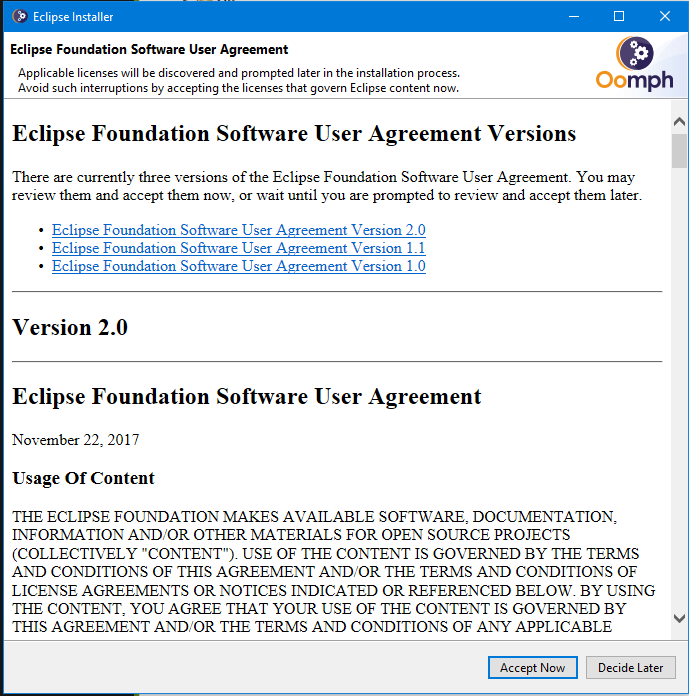
- #Not able to launch eclipse on mac how to
- #Not able to launch eclipse on mac install
- #Not able to launch eclipse on mac code
The memory leak in the application is discussed in depth in this tutorial. And the screenshots posted below are from the MAT plugin used with Eclipse IDE. We will be analyzing the heap dump generated by this Java application. After extracting the package open MemoryAnalyzer application to start using the standalone version of MAT.
#Not able to launch eclipse on mac install
Download the install standalone MAT application from this link. Download and install the Java Development Kit. Restart Eclipse and the plugin is ready to be used.ĭownloading the standalone version of Eclipse MAT. Search for Memory Analyzer and install it. Open Eclipse IDE and select Help > Eclipse Marketplace. There are two ways to use the Memory Analyzer tool. However, in this post, we will discuss the features provided with MAT. Apart from MAT, you can use Jhat, VisualVM. There are multiple paid and equally good open source tools available to analyze the Heap dump. Memory Analyzer (MAT) is one of the best open-source tool that can be used as a plugin with Eclipse or as a standalone application if you don’t have Eclipse IDE installed. Once you have the heap dump the next step is to analyze it using a tool. Which tools can be used to analyze the heap dump or open the. The parameter p1, if set to true, performs a GC before dumping the heap so that only live objects are present in the heap dump. Ensure that you add the “.hprof” extension at the end of the file name. The parameter p0 is the location and the name of the heap dump file. Before clicking on the dumpHeap function, set the parameters p0, p1 described below. Switch to MBeans tab and select > HotSpotDiagnostic > Operations > dumpHeap. After clicking on the heap dump you will be redirected to a new tab from which you can find out the location of your heap dump. Under the Monitor Tab, click on Heap Dump. Start Visual VM and connect your local Java Application to it. The following steps can be used to generate heap dump using VisualVM Visual VM makes it very easy to take a heap dump running on your local machine. The option live is important if you want to collect only the live objects i.e objects that still have a reference in the running code. After finding the pid, run the following command. The processes will be listed in the following format “ ” You can use the jps tool to list down all the running Java processes on your local machine.  Find the process id of your running Java application. These steps are common for all operating systems including Windows, Linux, and macOS. Command-line interface to generate the Heap Dump We will talk about the 3 easiest ways to do it. There are several ways to take a heap dump.
Find the process id of your running Java application. These steps are common for all operating systems including Windows, Linux, and macOS. Command-line interface to generate the Heap Dump We will talk about the 3 easiest ways to do it. There are several ways to take a heap dump. #Not able to launch eclipse on mac how to
How to take a Heap dump of your running Java Application In this case, you should either analyze the heap dump on the same server machine which doesn’t have memory constraint or use live memory sampling tools provided by VisualVM. Therefore, tools like MAT, Jhat won’t be able to load the heap dump file. For instance, a server may have crashed with a heap dump of size 24 GB and your local machine may only have 16 GB of memory.

Usually analyzing heap dump takes even more memory than the actual heap dump size and this may be problematic if you are trying to analyze heap dump from a large server on your development machine. How do you analyze very large Heap dumps?
#Not able to launch eclipse on mac code
We can also go into fine details and find out the amount of memory retained by a single Java object in the application. These details can help us pinpoint the actual code that is causing the memory leak issues. Using the heap dump we can find details like the memory usage per class, number of objects per class, etc. Analyzing the heap dump will lead us to the root cause of the anomaly.

You may need to take the Heap dump if your Java application is taking up more memory than you expected or your Java application crashed with OutOfMemoryError. Why and When should I take the Heap dump?

In this post, we will see how you can take the heap dump of your running Java application and use Eclipse’s Memory Analyzer (MAT) to identify memory hotspots and possibility detect memory leak. The heap dump file is usually stored with. Heap dump analysis using Eclipse Memory Analyzer Tool (MAT)Ī heap dump is a snapshot of all the Java objects that exist in the heap space.








 0 kommentar(er)
0 kommentar(er)
